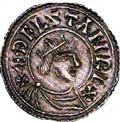Æthelstan was the son of King Eadweard the Elder, who probably intended a division of the kingdom after his death, between Æthelstan (in Mercia) and Ælfweard (in Wessex). It is conjectured, however, that the political establishment in Wessex chose Ælfweard, and that the establishment in Mercia set up Æthelstan in opposition to him. Ælfweard outlived his father by a couple of weeks and eventually Æthelstan succeeded to the whole kingdom. He was consecrated at Kingston on 4 Sep 925. Following the death of his brother-in-law Sihtric (c. 926), the Scandinavian king of Northumbria, Æthelstan took over his dominions. The submission of the kings of West Wales, Cumbria and Scots was completed by a treaty of Eamont, in north Derbyshire (12 Jul 926). Probably as a result of this action, Æthelstan laid his claim to the overlordship of Britain. His charters and coins bore the titles of 'rex Anglorum', 'rex tocius Britannie' and others, signifying a new period in history of Anglo-Saxon England. Æthelstan destroyed the Danish fortress at York, received the submission of the Welsh and drove the Cornish west of the Tamar. In 934 he invaded Scotland, which was submitted to his rule. However, three years later a league was formed against Æthelstan by Constantine, king of Scots, the Welsh of Strathclyde, and the Viking chieftains. In the Battle of Brunanburh (937) Æthelstan and his half-brother Eadmund (later King Eadmund) utterly destroyed the joined forces of their enemies. Æthelstan's half-sisters were married to the Frankish king Charles the Simple, Hugh count of Paris, and the German King Otto I. Apparently, Æthelstan was never married, and he was succeeded by Eadmund. Biography sources: [1][2][3][4] |

